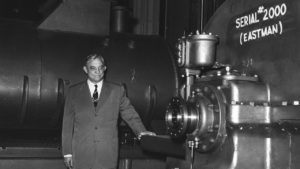 In 1902, engineer Willis Carrier was tasked with removing humidity from the air of the Sackett-Wilhelms Lithographing and Publishing Company in New York to keep paper from wrinkling and sticking together. When Carrier solved the problem of removing the humidity, he also created a magnificent side effect: the air was also cooled while it was “conditioned”. This new technology would have an astounding impact on how people live, work and play. In fact, British scholar S.F. Markham would say “The greatest contribution to civilization in this century may well be air conditioning.”
In 1902, engineer Willis Carrier was tasked with removing humidity from the air of the Sackett-Wilhelms Lithographing and Publishing Company in New York to keep paper from wrinkling and sticking together. When Carrier solved the problem of removing the humidity, he also created a magnificent side effect: the air was also cooled while it was “conditioned”. This new technology would have an astounding impact on how people live, work and play. In fact, British scholar S.F. Markham would say “The greatest contribution to civilization in this century may well be air conditioning.”
Carrier’s invention revolutionized not only indoor air comfort, but every business, industry, and home. Air conditioning systems were being installed in theaters as soon as 1922 and in department stores by the mid 1920’s. Air conditioning was installed in the White House in 1929 – and Franklin Delano Roosevelt hated it! Passengers on air conditioned trains were delighted that they arrive “just as clean” when they left the train as when they boarded. Air conditioners became so commonplace in homes in the 1950’s that they were no longer considered a status symbol.
Today, over 100 million homes in the United States have central air conditioning and 5.4 million air conditioners were shipped in 2018 alone. Air conditioners have enabled factories to locate in the southern states, prompted the population explosion in Arizona, and enabled Las Vegas to become the destination it is today.
Your central air conditioner is, amazingly, really pretty simple. There is a condenser, an evaporator and a compressor, with refrigerant circulating with a closed system of copper tubing. You may remember refrigerant being called “freon” but today it’s more likely to be hydrochlorofluorocarbons.
When your thermostat signals the system to start after the indoor air temperature hits your pre-set high, the cycle begins. Refrigerant is put under pressure by your compressor, typically outside of your home.
The refrigerant then moves to the condenser, which vents the heat out of the refrigerant using a large fan. It then moves to the evaporator coils. Now, the refrigerant absorbs the heat from the hot air that your indoor fans are pulling through return air ducts. As that air loses heat, fans push that now cooled air through the ductwork and vents in your home.
Throughout this cycle, your refrigerant turns from liquid to gas and back again, kind of like a lightening fast version of water boiling, melting and nearly freezing.
Amazingly, these mechanics are almost exactly what’s inside your kitchen’s refrigerator, making your home one huge fridge when you are running your air!
When you have a question about your air conditioner, call our office at 708-479-9350. We’ll be happy to help you achieve your optimum indoor comfort temperature.
As Popular Science wrote in 1932, with air-conditioning “every day inside is a fine day!”



Add Comment